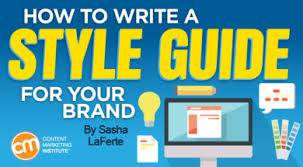How to create a style guide for your SEO content writers,How do I find good writers?How do I know if a writergets SEO,what is this document, really?Tabpear

How to create a style guide for your SEO content writers
To get the most out of your content writers, you need to set them on the right track from the start. How to develop guidelines and reduce the required editing time.

“How do I find good writers?”
“My writers are inconsistent.”

“How do I know if a writer ‘gets’ SEO?”
As someone who’s deeply immersed in the world of search engine-optimized (SEO) content writing, I hear these statements quite a bit.

What I find is that there seems to be a gap between the data-focused SEO pros and the creative copywriters they tend to hire. That is, it’s hard to find that sweet spot where a writer both understands SEO and how to write in a way that sells.
It’s essential that you have both pieces of the puzzle. Yet, SEO agencies and consultants often struggle to:
1 Find ‘good’ writers and
2 Train them how to write SEO-friendly content.
So, what’s the secret to getting your web page copy just right?
It all comes down to the magic of a well-organized, descriptive and mission-focused style guide or Standard Operating Procedure (SOP).
In this article, I give my “10 Essentials” for creating an effective style guide, as well as an example template that you can use for your own business.

What is a style guide vs. an SOP?
I often use “style guide” and “SOP” interchangeably, because what you really want to create for your writers is an all-encompassing guide on how to write SEO-friendly content for your site or your clients’ sites.
Many people separate these two, but that doesn’t have to be the case. In fact, I recommend being as concise as possible and not overwhelming your writers with too much “fluff.” They often don’t need to know all of the ins and outs of your entire brand (or robust SEO strategy, for that matter).
So, what is this document, really?
An SOP (aka Standard Operating Procedure) is a set of instructions on how to do something.
This can be used for SEO, writing, project management, onboarding clients or what-have-you. In our case, an SOP outlines how you want your writers to write you content.
I also tack on the style guide because there is a creative element to writing (something that other types of tasks often lack). Writers need to have an idea of what the brand is about, what kind of language should be used, who the target audience is and more.
That’s why including a style guide is an essential add-on to your typical SOP.
Why do you need a style guide for your content writers?
One of the biggest complaints I hear from SEO agencies and consultants is that they struggle to find consistent writers. Additionally, they feel that their writers don’t really understand SEO.
Well, I’ve got some news you may not want to hear: part of the reason your writers are inconsistent and don’t get SEO is your fault.
Sorry.
But let’s be honest — the typical SEO/writer engagement goes something like this:
Find a writer online
Send them the website URL, word count, topic, focus keywords and due date.
Let ‘em loose.
Receive the content.
Edit the heck out of it.
Not ideal.
There is a crucial step missing here, and that’s instruction.
Your writers can’t (and shouldn’t have to) read your mind.
If you give them limited information and direction, they are left to their own devices. The end result may be amazing, or it may be way off from what you expected. You can’t afford to have that kind of hit-or-miss engagement in your business.
It is your responsibility to outline your expectations, brand details, procedure, SEO strategy and desired writing format. This gives your writers the information they need to do the job right the first, second, third, fourth time… and so on.
By giving them a style guide, you set them up for success. You also help prevent the headache of receiving inconsistent work that you then have to edit on your own, which can be a huge time and money suck.
If you are struggling with getting consistent content from your writers or don’t know how to teach them SEO, then creating a style guide may be the best solution for you.
What information do you need to create a writing style guide?
Recently, I have done a couple of Facebook Live tutorials on what matters in SEO content writing, and I have come to recognize a common theme in the SEO space: Many SEO agencies haven’t done the front-loaded work of market research to adequately understand their audience or the audiences of their clients.
This means that, aside from the typical SEO data, they are essentially going in blind when it comes to writing content that sells.
And we all know that writing content that is SEO-friendly is only one part of the equation. Your content also needs to be able to drive conversions.
This realization was the main reason I decided to write this article. Many SEO pros struggle to write conversion-optimized content themselves, or to find writers who can write it for them. The information in a style guide should help you zero in on a successful approach.
So, I have outlined what you need to know before you can create a writing style guide.
The ‘10 Essential’ questions you need to answer before creating a style guide
1 Mission: What is the brand’s mission?
2 Words: What key taglines, words, phrases, tenses or perspectives are used and associated with this brand?
3 Purpose: What is the purpose for the content?
4 Audience: Who is the focus audience, and what are they like?
Solution: What is the problem the audience is facing, and how is this content a 5 solution to that problem?
6 Tone: What kind of tone does this brand convey, and how does that resonate with the audience?
7 Style: What style of writing does this brand use?
8 Organization: How does this brand organize its content? Does data support this approach?
9 Platform: What platforms will be used to drive traffic to this content?
10 Conversions: What kinds of conversions are we trying to make through the content?
Having answers to these questions for your own brand and every client you work with will both help you understand the brand better and communicate it with the people you work with, particularly writers.
If you don’t know these essentials, it’s likely that your content will fall flat. SEO and competitor analysis is not enough to go on when it comes to cultivating a message that truly resonates with the focus audience. In other words, it just won’t sell.
Note: If you are struggling to answer these questions, I suggest looking into the concept of the Ideal Client Avatar (ICA) or Persona. Developing these descriptions will help you paint a clear picture of what the brand’s audience looks like, what they want and need and what message relates to them best.
Tabpear is a Software Technology Co., Ltd which has many domestic excellent e-commerce platform R & D teams and mobile R & D teams. We divide the software engineer teams into several levels according to the project development experience. Level one is more than 3 years of development experience. Level two is more than five years of development experience. Level three is more than 10 years of development experience and Level four is expert team which has more than five participating in research projects, Invention patents and software copyrights of 6 or more, published in the core periodicals more than 10 papers. There is also a team ,working at cloud computing and service computing including four doctors, seven masters and 23 persons who have master's degree.
所有评论仅代表网友意见
